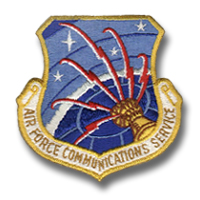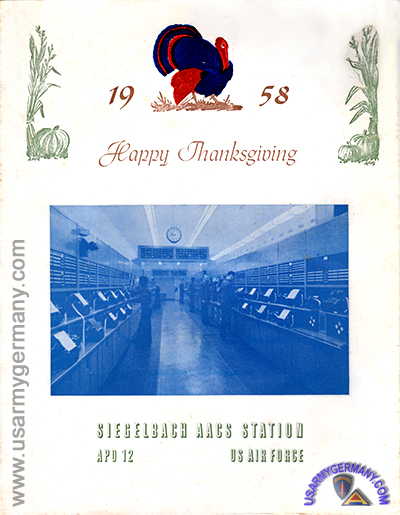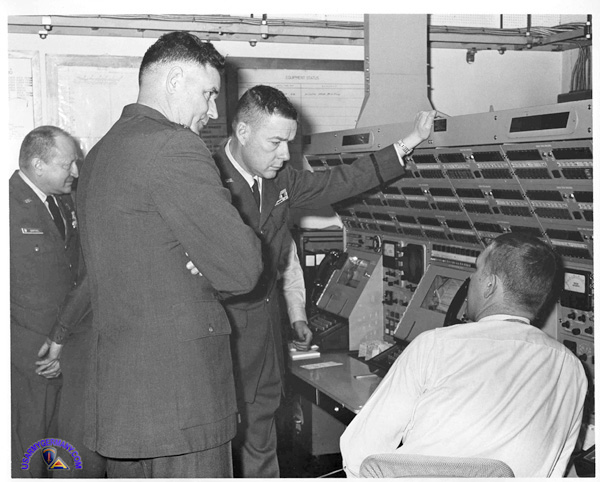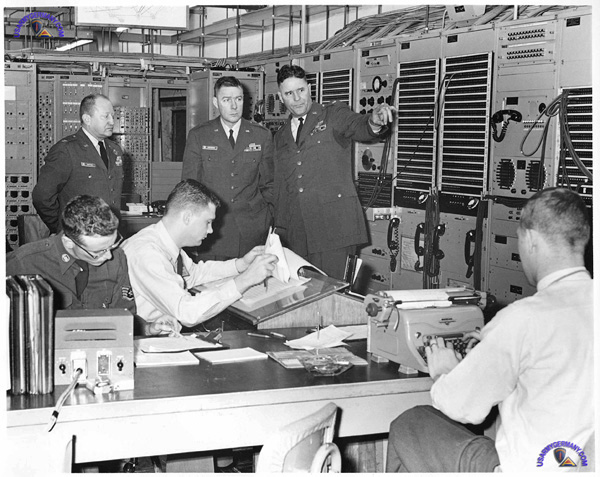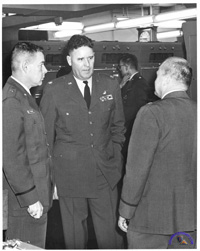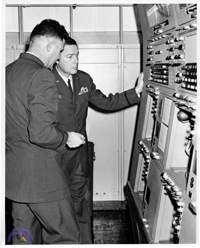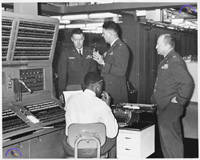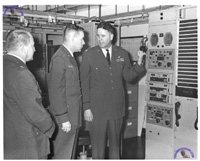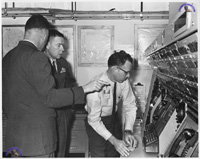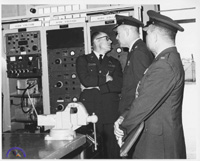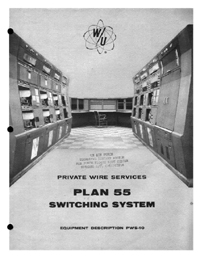| If you do
NOT see the Table of Contents frame to the left of this page, then
Click here to open 'USArmyGermany' frameset |
|||||||||||||
|
Siegelbach Primary Relay Site (RUFP) |
|||||||||||||
|
|
|||||||||||||
|
|||||||||||||
|
|
|||||||||||||
| History - Siegelbach Primary Relay | |||||||||||||
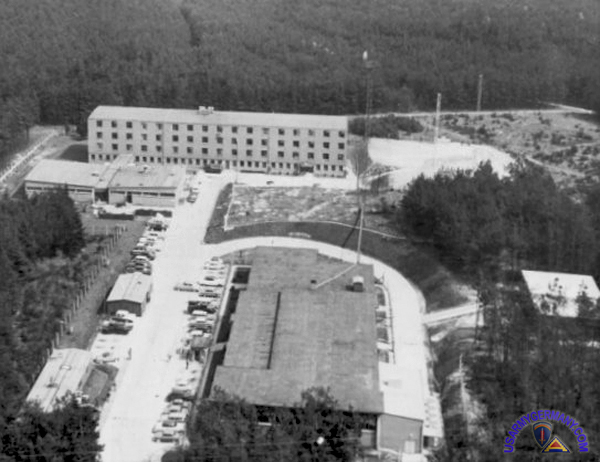 Siegelbach Primary Relay site, mid-1950s (1) |
|||||||||||||
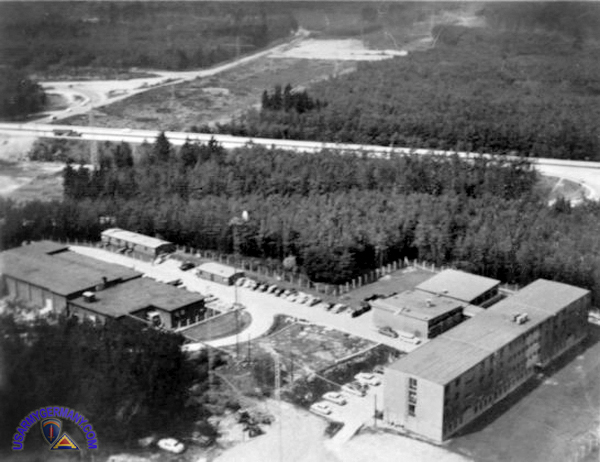 Siegelbach Primary Relay site, mid-1950s (1) |
|||||||||||||
| 1954 | |||||||||||||
| (Source: STARS & STRIPES, July 19, 1954) | |||||||||||||
| In mid-July 1954, the Siegelbach Switching Center sent a message to all Globecom communications centers world-wide, announcing that the Comm Center at Siegelbach was officially in operation. The Commander of the 1807th AACS Wing, Brig Gen Daniel C. Doubleday (**), threw the switch that sent the message around-the-world during a ceremony dedicating the new switching center. Construction of the new switching center began in 1951. The communication center is operated by the 2005th Communications Squadron. The Siegelbach unit reportedly operates the only semiautomatic teletype system currently located outside of the continental US. It is part of the Air Force's Globecom network. (**) BG Doubleday had just taken over the command of the 1807th from the previous CG -- BG Albert T. Wilso, Jr. -- in early June. |
|||||||||||||
| 1958 | |||||||||||||
| 1959 | |||||||||||||
| (Source: STARS & STRIPES, July 18, 1959) | |||||||||||||
| The Pacific phase of a new Air Force global communications network, with fully automatic high-speed communications centers, went into operation in July 1959 -- Hickham AFB, Hawaii and Fuchu Air Base, Japan. The European phase -- with new centers at Croughton, England; San Pablo, Spain; and Siegelbach, Germany -- is scheduled to be completed later this tear. At that time, the worldwide communications system with five new switching centers will be considered complete. (The domesting segment is already in operation and comprises a private wire network leased from Western Union. The Western Union segment links 250 Air Force stations throughout the US. ) When fully operational, the global network will cover a distance of 450,000 miles. |
|||||||||||||
| 1963 | |||||||||||||
| (Source: David Higginson, son of Brig Gen George M. Higginson, a former commander of the European-African-Middle Eastern Communications Area) | |||||||||||||
| These photos were taken during a tour of the Siegelbach facility by Brig Gen Higginson and Col Barthel, c. 1963. For more information on the Plan 55 system, see Bob Pollard's exellent "Data Communication Trivia" website. He has a section with a lot more details on the Plan 55 Switching Centers developed by Western Union in the early 1950s. |
|||||||||||||
|
|||||||||||||
| 1970 | |||||||||||||
| Siegelbach Primary Relay | |||||||||||||
| (Source: STARS & STRIPES, May 18 1970) | |||||||||||||
| On May 20 1970, the 2005th Communications Squadron will be inactivated at Siegelbach, Germany. The squadron had previously served as the hub of USAFE's direct dial phone system and as a primary link for teletype communications in Europe. The squadron's mission has been replaced by new computerized systems such as AUTOVON and AUTODIN. The 2005th CS was activated at Wiesbaden (Camp Pieri?) in July 1953 and subsequently moved to the Siegelbach site (November 1953). Initially, the squadron operated German-manufactured semi-automatic teletype equipment until this was replaced by the Plan 55 system in 1960 (2). Plan 55 equipment was designed and manufactured by Western Union and provided fully automatic tape processing capabilities. The Plan 55 primary relay center operated and maintained by the 2005th featured automatic traffic reception, simultaneous multi-address distribution and sequential numbering and transmission capabilities. The center provided teletype relay service throughout the European area and access for its tributaries to the Defense Communications System's world-wide teletype network. Under Plan 55, the center used to send and receive messages at 100 words per minute. In its heyday, the center ran about 48,000 manual cards a day - primarily supply requests. At one time, the 2005th Comm Sq had a strength of approximately 300 military personnel. (As the squadron closes down, there are 15 men left.) In the last phase of operations at Siegelbach, the relay center was linked via computer to the Pirmasens Automatic Switching Center (AUTODIN). The unit served as an interface between manual and automatic switching centers. Tributaries previously serviced by the Plan 55 system in Siegelbach have been absorbed by the three European AUTODIN relays (Pirmasens, Coltano and Croughton). ADDITIONAL INFORMATION The Automatic Teletype Relay Center at Siegelbach was officially opened on May 9, 1960. Siegelbach was one of 10 stations in the world-wide Plan 55 network. |
|||||||||||||
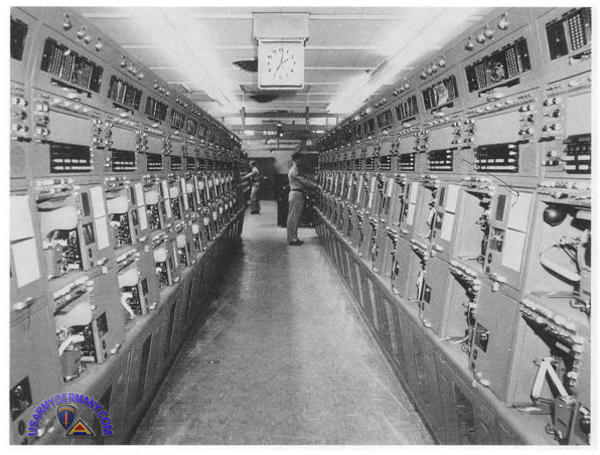 Siegelbach Primary Relay (Plan 55) equipment (3) |
|||||||||||||
| (1) Source: 2005th Communications Sq website - now defunct; accessd ca. 2007 (2) The Siegelbach Plan 55 site was one of three major (Air Force) automatic communications switching centers completed in Europe between 1959 and the early part of 1960: (3) Air Force photo |
|||||||||||||
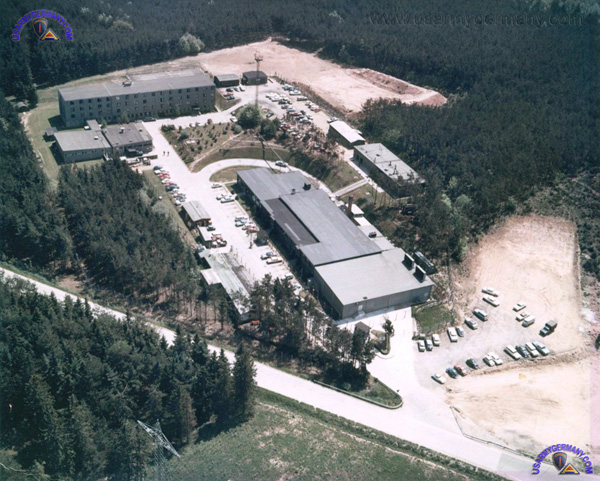 RUFP/Siegelbach, 1966 (1) |
|||||||||||||
| (Source: Dave Freed, moderator of the CommCenter-1 Yahoo Group) | |||||||||||||
The Air Force set up shop at a place called Siegelbach in Germany circa 1953. It was located on what was called Rhine Ordnance Barracks, (Kaiserslautern). (Note: The unit was originally organized at Camp Pieri in Wiesbaden and moved to Siegelbach in November 1953.) In 1959, the name was changed to Siegelbach Air Station. One of the primary units at Siegelbach was the 2005 Communications Squadron (USAF) which belonged to MATS (Military Air Transport Service). From a CommCenter standpoint, what is significant is that Siegelbachs' 2005th Comm Sq was also the operator of (then) Germany's largest tape relay station: RUFP, Primary Relay. In 1953, it was a manual tape relay. Some years later, it became a Plan 55 relay. At the time, most Army and Air Force tape relays connected to Siegelbach. Siegelbach, in 1960 and later, did not have tribs (most Primary Relays didn't). Primary Relays only connected to other relays, mostly other Primary Relays and Major Relays, whether torn tape, or semi-automatic. Siegelbach did have its own terminal station (RUFPC) and Relay Floor Services section, RUFPCM. The relay at Frankfurt (RUFM) had 2 circuits to RUFP, which were secured by KW-26Cs. RUFP had circuits to a few RUFP Minor Relays, such as RUFPAG (7th Army) at Heidelberg, and Major Relay RUFD (Pirmasens). RUFP/Siegelbach was closed down in 1968 when RUFT/ASC Pirmasens came online and ushered in the AUTODIN era for Germany. RUFT assumed Primary Relay status, along with RHFF (ASC Augsburg/Gablingen) and later, RUFL (ASC Coltano, IT). (RHFF closed in 1973, and was declared surplus). Today, Siegelbach Air Station is closed. Where the Plan 55 Relay once stood -- only the concrete building slab remains. There are several photos of the relay at this URL: http://bobp31.homestead.com/SIEGELBACH.html Having visited Siegelbach Relay a few times in the 60s, it was a "model" for its time, and the envy of all tape apes back then. The Air Force folks often conducted "seminars" and invited Army and Air Force commcenter out station folks to visit for day trips (or TDY over nights). Unlike tape relays, the Plan 55 was very quiet and everything shined. Few "operators" were ever present; everything was largely automatic. Mostly, you only saw KW-26 crypto folks, Tech Controllers (lots of them) and a few ops at the Service Positions. I never saw any tape apes. A side note: In tape relays, there were generally four (4) classes of relay stations: Primary Relays:.......Essentially GATEWAY stations that mostly connected to other relay stations. Primary Relays were also the conduit for overseas to CONUS connectivity, since Major Relays did not connect overseas (to CONUS). Primary Relays did not normally connect to tribs, other than its own terminal station and its Service sections or Room circuits. Major Relay:.........Connected to at least one Primary Relay, and any number of other Major and Minor Relays. Major Relays also had tribs of their own. Major Relays usually served a Corps, Theater Command or Minor Relay:.........Connected to at least one Major Relay and servcing mostly tribs of its own. Could also connect to other Minor Relays. Minor Relays usually served a Major Command, or Theater Area Support Command. Terminal Relays:...Any trib that had relay responsiblity but which was not classified as a tape relay (as above). These might include the circuits within a combat Division serving its individual Brigades, Regiments and Battalions. (For instance, 3rd Inf Div, Wurzburg, which was a "trib" tied off of RUFM/ Frankfurt, but which had 9 circuits of its own. 3ID was RUFMAZ. Its tribs were RUFMAZA thru RUFMAZI). Another example would be 8th Inf Div at RUFMEI/Bad Kreuznach. It had 8 tribs, RUFMEIA thru RUFMEIH). This was 1960s era stuff. |
|||||||||||||
| Plan 55 System | |||||||||||||
| (Source: Data Communication Trivia - a Data Communication Historical Series by Bob Pollard, website) | |||||||||||||
|
|||||||||||||
| Related Links | |||||||||||||
|
|||||||||||||
